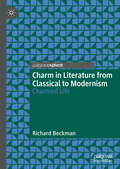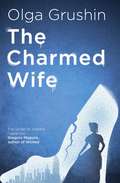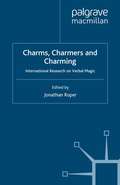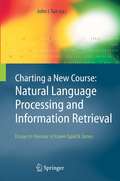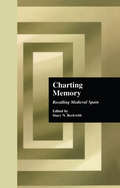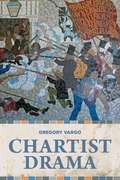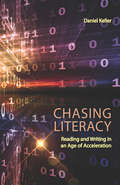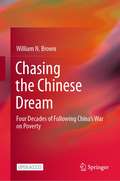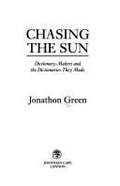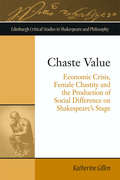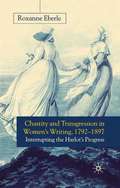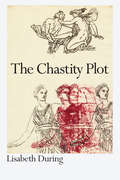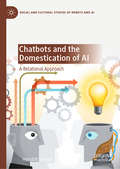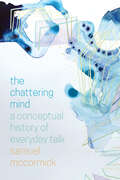- Table View
- List View
Charm in Literature from Classical to Modernism: Charmed Life
by Richard BeckmanCharm in Literature from Classical to Modernism: Charmed Life discusses charm as both an emotional and aesthetic phenomenon. Beginning with the first appearance of literary charm in the Sirens episode of the Odyssey, Richard Beckman traces charm throughout canonical literature, examining the metamorphoses of charm through the millennia. The book examines the works of Chaucer, Spenser, Shakespeare, Milton, Pope, Wordsworth, Coleridge, Proust, Joyce, Mann, and others, considering the multiplicity of ways charm is defined, depicted, and utilized by authors. Positioning these poems, dramas, and novels as case studies, Beckman reveals the mercurial yet enduring connotations of charm.
The Charmed Wife: A beautifully written, powerful reimagining that picks up thirteen years after Cinderella and Prince Charming said ‘I do’
by Olga Grushin*An Oprah Magazine Most Anticipated Book of 2021**A Woman & Home Top Four Literary Read**A lovereading.co.uk Star Book* And they lived happily ever after . . . didn't they?Cinderella married the man of her dreams - the perfect ending she deserved after diligently following all the fairy-tale rules. Yet now, two children and thirteen-and-a-half years later, things have gone badly wrong. One night, she sneaks out of the palace to get help from the Witch who, for a price, offers love potions to disgruntled housewives. But as the old hag flings the last ingredients into the cauldron, Cinderella doesn't ask for a love spell to win back her Prince Charming. Instead, she wants him dead. Endlessly surprising and wildly inventive, The Charmed Wife is a sophisticated literary fairy tale for the twenty-first century that weaves together time and place, fantasy and reality, to conjure a world unlike any other. Nothing in it is quite what it seems, and the twists and turns of its magical, dark, swiftly shifting paths take us deep into the heart of romance, marriage and the very nature of storytelling.'Dark and dreamy. Inside the plot, magic comes and goes. But inside the reader, it's all magic - all of us happily caught in Grushin's hypnotic spell.' - Karen Joy Fowler, author of We Are All Completely Beside Ourselves and The Jane Austen Book Club'Fall under its charms, I dare you' - Gregory Maguire, author of WickedA powerful, provocative and quite wonderful modern literary fairy tale. I danced through the deep dark magic of The Charmed Wife - long live the fairy tale that lives beyond "happily ever after".' - lovereading.co.uk'Surprising, darkly comedic and enchanting' - CNN'Genre-bending and darkly comic, Grushin's fourth novel is a weird and wonderful triumph.' - Oprah Magazine
Charms, Charmers and Charming: International Research on Verbal Magic (Palgrave Historical Studies in Witchcraft and Magic)
by J. RoperBringing together many of today's key scholars of verbal charming, these essays cover vernacular magical texts and practice from Malaysia to Madagascar, and from England to Estonia. As the most comprehensive collection of research on charms, charmers and charming available in the English language, it forms an essential reader on the topic.
Charting a New Course: Essays in Honour of Karen Spärck Jones (The Information Retrieval Series #16)
by John I. TaitKaren Spärck Jones is one of the major figures of 20th century and early 21st Century computing and information processing. Her ideas have had an important influence on the development of Internet Search Engines. Her contribution has been recognized by awards from the natural language processing, information retrieval and artificial intelligence communities, including being asked to present the prestigious Grace Hopper lecture. She continues to be an active and influential researcher. Her contribution to the scientific evaluation of the effectiveness of such computer systems has been quite outstanding. This book celebrates the life and work of Karen Spärck Jones in her seventieth year. It consists of fifteen new and original chapters written by leading international authorities reviewing the state of the art and her influence in the areas in which Karen Spärck Jones has been active. Although she has a publication record which goes back over forty years, it is clear even the very early work reviewed in the book can be read with profit by those working on recent developments in information processing like bioinformatics and the semantic web.
Charting Memory: Recalling Medieval Spain (Hispanic Issues)
by Stacy N. BeckwithCharting Memory: Recalling Medieval Spain elaborates an interdiscursive picture of how Medieval Spain has been remembered by various Arab, Jewish, and Hispanic peoples from well before 1492 to the present. The collection breaks with traditional foci on the legacies of separate Iberian communities and their descendants, and on limited, largely textual sets of their related cultural practices. In distinct ways, this collection takes a multi-ethnic and multi-modal approach, departing from sociologist Maurice Halbwachs' premise that collective memories form not within individuals alone, but through the inner and inter-workings of actual and conceptual social milieux. The volume hereby foregrounds the constitutive roles of communities created through prayer, literary resonances, architecture, musical performance, and name giving, in shaping memories of medieval Spanish contexts as well as complex identities in the Balkans, the Near and Middle East, North Africa, Latin American, and the United States. The ten original essays in this collection, by international specialists in anthropology, ethnomusicology, literary criticism, folklore, and onomastics, are not arranged according to Arab, Jewish, and Hispanic cultural memories of medieval Spain. Instead, the collection's unique comparative emphasis illuminates ways in which various peoples have re-articulated memories relating to medieval Spain in and across physical, temporal, and social locations, with different types and degrees of impact.
Charting Memory: Recalling Medieval Spain (Hispanic Issues #Vol. 21)
by Stacy N. BeckwithCharting Memory: Recalling Medieval Spain elaborates an interdiscursive picture of how Medieval Spain has been remembered by various Arab, Jewish, and Hispanic peoples from well before 1492 to the present. The collection breaks with traditional foci on the legacies of separate Iberian communities and their descendants, and on limited, largely textual sets of their related cultural practices. In distinct ways, this collection takes a multi-ethnic and multi-modal approach, departing from sociologist Maurice Halbwachs' premise that collective memories form not within individuals alone, but through the inner and inter-workings of actual and conceptual social milieux. The volume hereby foregrounds the constitutive roles of communities created through prayer, literary resonances, architecture, musical performance, and name giving, in shaping memories of medieval Spanish contexts as well as complex identities in the Balkans, the Near and Middle East, North Africa, Latin American, and the United States. The ten original essays in this collection, by international specialists in anthropology, ethnomusicology, literary criticism, folklore, and onomastics, are not arranged according to Arab, Jewish, and Hispanic cultural memories of medieval Spain. Instead, the collection's unique comparative emphasis illuminates ways in which various peoples have re-articulated memories relating to medieval Spain in and across physical, temporal, and social locations, with different types and degrees of impact.
Chartist drama
by Gregory VargoThe first collection of its kind, Chartist Drama makes available four plays written or performed by members of the Chartist movement of the 1840s. Emerging from the lively counter-culture of this protest campaign for democratic rights, these plays challenged cultural as well as political hierarchies by adapting such recognisable genres as melodrama, history plays, and tragedy for performance in radically new settings. They include poet-activist John Watkins’s John Frost, which dramatises the gripping events of the Newport rising, in which twenty-two Chartists lost their lives in what was probably a misfired attempt to spark a nationwide rebellion. Gregory Vargo’s introduction and notes elucidate the previously unexplored world of Chartist dramatic culture, a context that promises to reshape what we know about early Victorian popular politics and theatre.
Chartist drama
by Gregory VargoThe first collection of its kind, Chartist Drama makes available four plays written or performed by members of the Chartist movement of the 1840s. Emerging from the lively counter-culture of this protest campaign for democratic rights, these plays challenged cultural as well as political hierarchies by adapting such recognisable genres as melodrama, history plays, and tragedy for performance in radically new settings. They include poet-activist John Watkins’s John Frost, which dramatises the gripping events of the Newport rising, in which twenty-two Chartists lost their lives in what was probably a misfired attempt to spark a nationwide rebellion. Gregory Vargo’s introduction and notes elucidate the previously unexplored world of Chartist dramatic culture, a context that promises to reshape what we know about early Victorian popular politics and theatre.
Chasing Literacy: Reading and Writing in an Age of Acceleration
by Daniel KellerArguing that composition should renew its interest in reading pedagogy and research, Chasing Literacy offers writing instructors and literacy scholars a framework for understanding and responding to the challenges posed by the proliferation of interactive and multimodal communication technologies in the twenty-first century. Employing case-study research of student reading practices, Keller explores reading-writing connections in new media contexts. He identifies a culture of acceleration—a gathering of social, educational, economic, and technological forces that reinforce the values of speed, efficiency, and change—and challenges educators to balance new “faster” literacies with traditional “slower” literacies. In addition, Keller details four significant features of contemporary literacy that emerged from his research: accumulation and curricular choices; literacy perceptions; speeds of rhetoric; and speeds of reading. Chasing Literacy outlines a new reading pedagogy that will help students gain versatile, dexterous approaches to both reading and writing and makes a significant contribution to this emerging area of interest in composition theory and practice.
Chasing Shadows: A true story of drugs, war and the secret world of international crime
by Miles Johnson'As breathless, complex and on-the-edge suspenseful as the finest thriller fiction - but it's all real, which makes it truly extraordinary' Lee Child'McMafia for the new age' Catherine Belton, author of Putin's People: How the KGB Took Back Russia and then took on the West'Compelling, visceral and highly readable' Oliver Bullough, bestselling author of Moneyland'This astonishing and cinematic rollercoaster of a debut will bring Miles Johnson's talent into the brilliant light. Delivered with trademark verve and precision, it achieves that rare and precious thing that is the goal of all great reporting: it reveals the world to itself' Alex Perry, author of The Good Mothers'Miles has used his extensive Italian contacts to get a fully-fleshed out story in the Mafia section; likewise with the Hezbollah characters. He has interviewed over 100 people for the book, including many hours with Jack Kelly, the DEA investigator and hero of the book, which gives us an intimate look at a man dedicated to catching bad guys at the expense of his personal life' Dan McCrum, author of Money MenA compulsive true crime thriller about modern-day international drugs trafficking, terrorism and geopolitical intrigue following an investigation driven by one DEA agent, Jack Kelly. Three very different men battle to control their destinies as they hurtle through the hall of mirrors of the global shadow economy.Jack Kelly, a veteran US Drug Enforcement Administration agent, tasked with following a trail of dirty money across continents from a top-secret investigative unit based in Virginia.Salvatore Pititto is an ambitious Mafia capo working on a vast cocaine shipment who becomes unexpectedly pulled into an arms-smuggling conspiracy. Mustafa Badreddine is a ghost-like master terrorist wanted by governments across the world who has been secretly dispatched to Syria for his final mission. Each man, born in radically different circumstances in the 1960s, is in his own way grappling with the powerful and unstoppable forces that shape the world around us; forces which topple governments, send refugees fleeing across borders, and put guns in the hands of mercenaries and militias. Each has devoted his whole life to an institution-the DEA, the Mafia and the Lebanese militant group Hezbollah-and each will eventually be destroyed or betrayed by the thing they believe in the most.Set during 2015 and 2016, as the global order began to implode under the pressures of the Syrian civil war and the European refugee crisis, CHASING SHADOWS looks back over the historical conflicts, events and personal histories that have shaped the lives of these three men. It's a book that shows the betrayals, the disillusionment and the violence as Jack Kelly hunts down his targets.
Chasing the Chinese Dream: Four Decades of Following China’s War on Poverty
by William N. BrownThis open access book explores the historical, cultural and philosophical contexts that have made anti-poverty the core of Chinese society since Liberation in 1949, and why poverty alleviation measures evolved from the simplistic aid of the 1950s to Xi Jinping’s precision poverty alleviation and its goal of eliminating absolute poverty by 2020. The book also addresses the implications of China’s experience for other developing nations tackling not only poverty but such issues as pandemics, rampant urbanization and desertification exacerbated by global warming. The first of three parts draws upon interviews of rural and urban Chinese from diverse backgrounds and local and national leaders. These interviews, conducted in even the remotest areas of the country, offer candid insights into the challenges that have forced China to continually evolve its programs to resolve even the most intractable cases of poverty. The second part explores the historic, cultural and philosophical roots of old China’s meritocratic government and how its ancient Chinese ethics have led to modern Chinese socialism’s stance that “poverty amidst plenty is immoral”. Dr. Huang Chengwei, one of China’s foremost anti-poverty experts, explains the challenges faced at each stage as China’s anti-poverty measures evolved over 70 years to emphasize “enablement” over “aid” and to foster bottom-up initiative and entrepreneurialism, culminating in Xi Jinping’s precision poverty alleviation. The book also addresses why national economic development alone cannot reduce poverty; poverty alleviation programs must be people-centered, with measurable and accountable practices that reach even to household level, which China has done with its “First Secretary” program. The third part explores the potential for adopting China’s practices in other nations, including the potential for replicating China’s successes in developing countries through such measures as the Belt and Road Initiative. This book also addresses prevalent misperceptions about China’s growing global presence and why other developing nations must address historic, systemic causes of poverty and inequity before they can undertake sustainable poverty alleviation measures of their own.
Chasing the Sun: Dictionary-makers and the Dictionaries They Made
by Jonathon GreenIn this book Jonathon Green traces the history of the dictionary from the first lexicon created in 2340 B.C. to the pinnacle of the Oxford English Dictionary and today's computer-generated successors of that great masterwork.
Chasing the Sun: Dictionary-makers and the Dictionaries They Made (PDF)
by Jonathon GreenIn this book Jonathon Green traces the history of the dictionary from the first lexicon created in 2340 B.C. to the pinnacle of the Oxford English Dictionary and today's computer-generated successors of that great masterwork.
Chaste Value: Economic Crisis, Female Chastity and the Production of Social Difference on Shakespeare's Stage (Edinburgh Critical Studies in Shakespeare and Philosophy)
by Katherine GillenChaste Value reassesses chastity’s significance in early modern drama, arguing that presentations of chastity inform the stage’s production of early capitalist subjectivity and social difference. Plays invoke chastity—itself a quasi-commodity—to interrogate the relationship between personal and economic value. Through chastity discourse, the stage disrupts pre-capitalist ideas of intrinsic value while also reallocating such value according to emerging hierarchies of gender, race, class, and nationality. Chastity, therefore, emerges as a central category within early articulations of humanity, determining who possesses intrinsic value and, conversely, whose bodies and labor can be incorporated into market exchange.
Chaste Value: Economic Crisis, Female Chastity and the Production of Social Difference on Shakespeare's Stage (Edinburgh Critical Studies in Shakespeare and Philosophy)
by Katherine GillenA lively account of London's writing in the 1930s
Chastity and Transgression in Women's Writing, 1792-1897: Interrupting the Harlot's Progress
by R. EberleWorking at the intersections of feminist literary criticism, new historicism, and narratology, Chastity and Transgression in Women's Writing revises current understandings of nineteenth-century representations of prostitution, female sexuality and the 'rights of woman' debate. Eberle's project explores the connections and disjunctures between women writing during the Romantic period and those working throughout the Victorian era. She considers a wide range of authors including Mary Wollstonecraft, Amelia Opie, Mary Hays, Elizabeth Gaskell, and Sarah Grand.
The Chastity Plot
by Lisabeth DuringIn The Chastity Plot, Lisabeth During tells the story of the rise, fall, and transformation of the ideal of chastity. From its role in the practice of asceticism to its associations with sovereignty, violence, and the purity of nature, it has been loved, honored, and despised. Obsession with chastity has played a powerful and disturbing role in our moral imagination. It has enforced patriarchy’s double standards, complicated sexual relations, and imbedded in Western culture a myth of gender that has been long contested by feminists. Still not yet fully understood, the chastity plot remains with us, and the metaphysics of purity continue to haunt literature, religion, and philosophy. Idealized and unattainable, sexual renunciation has shaped social institutions, political power, ethical norms, and clerical abuses. It has led to destruction and passion, to seductive fantasies that inspired saints and provoked libertines. As During shows, it should not be underestimated. Examining literature, religion, psychoanalysis, and cultural history from antiquity through the middle ages and into modernity, During provides a sweeping history of chastity and insight into its subversive potential. Instead of simply asking what chastity is, During considers what chastity can do, why we should care, and how it might provide a productive disruption, generating new ways of thinking about sex, integrity, and freedom.
The Chastity Plot
by Lisabeth DuringIn The Chastity Plot, Lisabeth During tells the story of the rise, fall, and transformation of the ideal of chastity. From its role in the practice of asceticism to its associations with sovereignty, violence, and the purity of nature, it has been loved, honored, and despised. Obsession with chastity has played a powerful and disturbing role in our moral imagination. It has enforced patriarchy’s double standards, complicated sexual relations, and imbedded in Western culture a myth of gender that has been long contested by feminists. Still not yet fully understood, the chastity plot remains with us, and the metaphysics of purity continue to haunt literature, religion, and philosophy. Idealized and unattainable, sexual renunciation has shaped social institutions, political power, ethical norms, and clerical abuses. It has led to destruction and passion, to seductive fantasies that inspired saints and provoked libertines. As During shows, it should not be underestimated. Examining literature, religion, psychoanalysis, and cultural history from antiquity through the middle ages and into modernity, During provides a sweeping history of chastity and insight into its subversive potential. Instead of simply asking what chastity is, During considers what chastity can do, why we should care, and how it might provide a productive disruption, generating new ways of thinking about sex, integrity, and freedom.
Chatbots and the Domestication of AI: A Relational Approach (Social and Cultural Studies of Robots and AI)
by Hendrik KemptThis book explores some of the ethical, legal, and social implications of chatbots, or conversational artificial agents. It reviews the possibility of establishing meaningful social relationships with chatbots and investigates the consequences of those relationships for contemporary debates in the philosophy of Artificial Intelligence. The author introduces current technological challenges of AI and discusses how technological progress and social change influence our understanding of social relationships. He then argues that chatbots introduce epistemic uncertainty into human social discourse, but that this can be ameliorated by introducing a new ontological classification or 'status' for chatbots. This step forward would allow humans to reap the benefits of this technological development, without the attendant losses. Finally, the author considers the consequences of chatbots on human-human relationships, providing analysis on robot rights, human-centered design, and the social tension between robophobes and robophiles.
The Chattering Mind: A Conceptual History of Everyday Talk
by Samuel McCormickFrom Plato’s contempt for “the madness of the multitude” to Kant’s lament for “the great unthinking mass,” the history of Western thought is riddled with disdain for ordinary collective life. But it was not until Kierkegaard developed the term chatter that this disdain began to focus on the ordinary communicative practices that sustain this form of human togetherness. The Chattering Mind explores the intellectual tradition inaugurated by Kierkegaard’s work, tracing the conceptual history of everyday talk from his formative account of chatter to Heidegger’s recuperative discussion of “idle talk” to Lacan’s culminating treatment of “empty speech”—and ultimately into our digital present, where small talk on various social media platforms now yields big data for tech-savvy entrepreneurs. In this sense, The Chattering Mind is less a history of ideas than a book in search of a usable past. It is a study of how the modern world became anxious about everyday talk, figured in terms of the intellectual elites who piqued this anxiety, and written with an eye toward recent dilemmas of digital communication and culture. By explaining how a quintessentially unproblematic form of human communication became a communication problem in itself, McCormick shows how its conceptual history is essential to our understanding of media and communication today.
The Chattering Mind: A Conceptual History of Everyday Talk
by Samuel McCormickFrom Plato’s contempt for “the madness of the multitude” to Kant’s lament for “the great unthinking mass,” the history of Western thought is riddled with disdain for ordinary collective life. But it was not until Kierkegaard developed the term chatter that this disdain began to focus on the ordinary communicative practices that sustain this form of human togetherness. The Chattering Mind explores the intellectual tradition inaugurated by Kierkegaard’s work, tracing the conceptual history of everyday talk from his formative account of chatter to Heidegger’s recuperative discussion of “idle talk” to Lacan’s culminating treatment of “empty speech”—and ultimately into our digital present, where small talk on various social media platforms now yields big data for tech-savvy entrepreneurs. In this sense, The Chattering Mind is less a history of ideas than a book in search of a usable past. It is a study of how the modern world became anxious about everyday talk, figured in terms of the intellectual elites who piqued this anxiety, and written with an eye toward recent dilemmas of digital communication and culture. By explaining how a quintessentially unproblematic form of human communication became a communication problem in itself, McCormick shows how its conceptual history is essential to our understanding of media and communication today.
The Chattering Mind: A Conceptual History of Everyday Talk
by Samuel McCormickFrom Plato’s contempt for “the madness of the multitude” to Kant’s lament for “the great unthinking mass,” the history of Western thought is riddled with disdain for ordinary collective life. But it was not until Kierkegaard developed the term chatter that this disdain began to focus on the ordinary communicative practices that sustain this form of human togetherness. The Chattering Mind explores the intellectual tradition inaugurated by Kierkegaard’s work, tracing the conceptual history of everyday talk from his formative account of chatter to Heidegger’s recuperative discussion of “idle talk” to Lacan’s culminating treatment of “empty speech”—and ultimately into our digital present, where small talk on various social media platforms now yields big data for tech-savvy entrepreneurs. In this sense, The Chattering Mind is less a history of ideas than a book in search of a usable past. It is a study of how the modern world became anxious about everyday talk, figured in terms of the intellectual elites who piqued this anxiety, and written with an eye toward recent dilemmas of digital communication and culture. By explaining how a quintessentially unproblematic form of human communication became a communication problem in itself, McCormick shows how its conceptual history is essential to our understanding of media and communication today.
The Chattering Mind: A Conceptual History of Everyday Talk
by Samuel McCormickFrom Plato’s contempt for “the madness of the multitude” to Kant’s lament for “the great unthinking mass,” the history of Western thought is riddled with disdain for ordinary collective life. But it was not until Kierkegaard developed the term chatter that this disdain began to focus on the ordinary communicative practices that sustain this form of human togetherness. The Chattering Mind explores the intellectual tradition inaugurated by Kierkegaard’s work, tracing the conceptual history of everyday talk from his formative account of chatter to Heidegger’s recuperative discussion of “idle talk” to Lacan’s culminating treatment of “empty speech”—and ultimately into our digital present, where small talk on various social media platforms now yields big data for tech-savvy entrepreneurs. In this sense, The Chattering Mind is less a history of ideas than a book in search of a usable past. It is a study of how the modern world became anxious about everyday talk, figured in terms of the intellectual elites who piqued this anxiety, and written with an eye toward recent dilemmas of digital communication and culture. By explaining how a quintessentially unproblematic form of human communication became a communication problem in itself, McCormick shows how its conceptual history is essential to our understanding of media and communication today.
The Chattering Mind: A Conceptual History of Everyday Talk
by Samuel McCormickFrom Plato’s contempt for “the madness of the multitude” to Kant’s lament for “the great unthinking mass,” the history of Western thought is riddled with disdain for ordinary collective life. But it was not until Kierkegaard developed the term chatter that this disdain began to focus on the ordinary communicative practices that sustain this form of human togetherness. The Chattering Mind explores the intellectual tradition inaugurated by Kierkegaard’s work, tracing the conceptual history of everyday talk from his formative account of chatter to Heidegger’s recuperative discussion of “idle talk” to Lacan’s culminating treatment of “empty speech”—and ultimately into our digital present, where small talk on various social media platforms now yields big data for tech-savvy entrepreneurs. In this sense, The Chattering Mind is less a history of ideas than a book in search of a usable past. It is a study of how the modern world became anxious about everyday talk, figured in terms of the intellectual elites who piqued this anxiety, and written with an eye toward recent dilemmas of digital communication and culture. By explaining how a quintessentially unproblematic form of human communication became a communication problem in itself, McCormick shows how its conceptual history is essential to our understanding of media and communication today.
The Chattering Mind: A Conceptual History of Everyday Talk
by Samuel McCormickFrom Plato’s contempt for “the madness of the multitude” to Kant’s lament for “the great unthinking mass,” the history of Western thought is riddled with disdain for ordinary collective life. But it was not until Kierkegaard developed the term chatter that this disdain began to focus on the ordinary communicative practices that sustain this form of human togetherness. The Chattering Mind explores the intellectual tradition inaugurated by Kierkegaard’s work, tracing the conceptual history of everyday talk from his formative account of chatter to Heidegger’s recuperative discussion of “idle talk” to Lacan’s culminating treatment of “empty speech”—and ultimately into our digital present, where small talk on various social media platforms now yields big data for tech-savvy entrepreneurs. In this sense, The Chattering Mind is less a history of ideas than a book in search of a usable past. It is a study of how the modern world became anxious about everyday talk, figured in terms of the intellectual elites who piqued this anxiety, and written with an eye toward recent dilemmas of digital communication and culture. By explaining how a quintessentially unproblematic form of human communication became a communication problem in itself, McCormick shows how its conceptual history is essential to our understanding of media and communication today.
